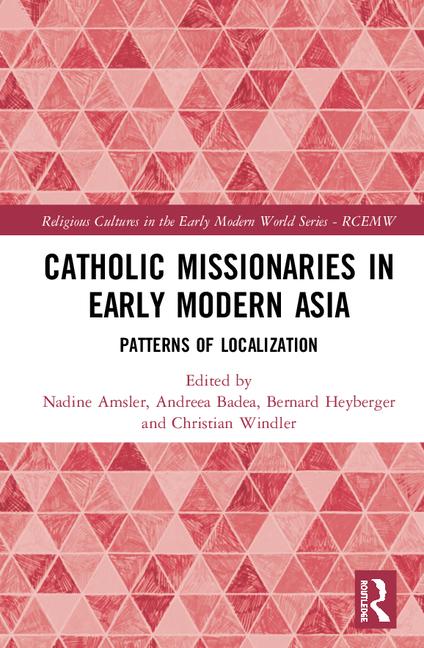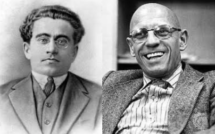
Catholic Missionaries in Early Modern Asia Patterns of Localization Edited by Nadine Amsler, Andreea Badea, Bernard Heyberger, and Christian Windler
This is part of a roundtable Studying Europe Through the Lens of European Catholicism, and our special feature, Imagining, Thinking, and Teaching Europe.

Throughout this edited volume, contributors explore how Catholic missionaries have engaged with Asian societies during the sixteenth, seventeenth, and eighteenth centuries and how, through these interactions, Catholicism became a local reality. The volume understands Asia as what stands on the Eastern side of the Bosporus strait and includes material from Japan, China, Tibet, Persia, and Palestine. To guide the reader and allow more cross-regional comparisons, the book is structured in four parts; each discussing one social stratum into which missionaries have asserted themselves. Thus, the book distinguishes between the courts, the cities, the countryside, and households. These four levels of social reality not only provide a framework for the book, but also highlight the political sophistication and cultural diversity of the societies with which early missionaries engaged.
The main argument of this volume is that localization is not the diffusion of a homogeneous and Eurocentric Catholicism to Asia. On the contrary, the core dynamic lies in the encounter between individual missionaries, converts, and non-Christians. For example, Cesare Santus investigates how Jesuit, Franciscan, and Capuchin missionaries serving in Ottoman Damascus have displayed conflicting views on Eastern Churches and local social structures. While Jesuits have often been portrayed by Church historians as champions of accommodation as opposed to “Franciscan rigorists,” the situation in the Near East shows that it is impossible to reduce a religious order to any specific policy for introducing Catholicism to local communities. Variations among members and locations prohibit such generalizations. In a similar vein, Christian Windler unfolds the approaches used by the Augustinians and Discalced Carmelites to secure their position at the Safavid court and highlights how contradictory priorities have generated conflicts within religious orders. Thus, the translation of Catholicism into early modern Asian societies was nothing like the spread of a monolithic set of practices and beliefs. Instead, Catholic organizations participating in this cross-continental transfer went through unprecedented forms of internal tension and conflicts, and their members had to respond to new kinds of social and religious actors, as well as to new cultural environments, all of which challenged the universalist ideology of European Catholicism.
Furthermore, the territories in which this heterogeneous array of missionary actors were engaging were similarly as diverse and dynamic. Contributors show how far these local places were from being isolated and homogenous territories. Various social strata and geographical areas constantly overlapped and interacted to define features of “local” Catholicism in Japan, China, and Palestine. For instance, Felicita Tramontana shows that Franciscans based in seventeenth century Bethlehem were trading spiritual and earthly goods through networks of city-connected economic and social systems, as well as through rural and desert areas situated far beyond their well-known village. Similarly, Ronnie Hsia shows that patterns of patronage and the urban-rural structures of late imperial China explain far more how early Chinese Catholicism was organized than the Post-Tridentine model of the Latin Church. In short, localization is not only influenced by the “local.”
The coherence of the volume’s diverse chapters lies in a common interest in identifying patterns of transmission and negotiation that narrate the religiously driven Euro-Asian encounter occurring throughout the missionary enterprise. Contributors share the conviction that the role played by individual actors is the key factor of the equation. In other words, Syriac and Maronite Christians, non-Christian officials, local patrons, Chinese literati, Japanese peasants, and educated women are all participating in the shaping of various local forms of Catholicism as well as their narratives and practices. Thus, the search for patterns of localization is not done solely from the point of view of Europeans, nor from the perspective of local actors, but from both of them. Each contributor explores, through a distinct angle, what occurs between these diverse actors, and what conspires when Catholicism is translated into a non-European society. Consequently, this edited volume is clearly not an additional study of the encountered Others or a study of how Europeans perceived them, but an investigation of the transformative processes that occur when two populations encounter other.
Consequently, for most contributors, localization remains understood as a process of transfer and adaptation. Localization is about what happens to Catholicism. In dialogue with various actors, and because of non-negotiable constraints, missionaries co-adjust Catholic discourses and practices to particular situations and their differentiated social circles. However, one study offers a rather distinct approach that advances the conversation on localization. In her study of the Kirishitan literature, Haruko Nawata Ward explores the central role that Japanese women have played in not only translating Christian ideals and values into Early Edo Japan, but also in creating a new “third space” in which to live their religion. This new site of Christian cultivation and worship was located inside Christian households, but “crisscrossed between the foreign and the local, public and private, communal and domestic, clergy and lay, and male and female spheres” (174). There, women were entitled to write, preach, teach, baptize, and organize a liturgy. Consequently, the encounter with Catholicism redefined conventional understandings of the household and opened new possibilities that were neither typically “Japanese” nor “European.” Thus, localization is not only the collaborative adaptation to a local context, but also the redefinition of categories that characterize what the “local” is. Localization is about the re-production and translation of the local.
Furthermore, one must notice that, for the majority of the contributors, material artifacts sustaining the Euro-Asian religious encounter represent an important starting point of investigation. Contributors look not only at the narratives that missionaries and Asian populations have formulated together, but also at the physical objects that participated in and shaped their new relationships. For instance, Eugenio Menego explores the evolving dressing codes of the Jesuits serving in late imperial China and recalls how clothes were used to proclaim religious identity, social hierarchy, and cultural boundaries. Nadine Amsler looks at the oratories developed within Chinese households during late imperial China and shows how they reveal the concessions made by the Jesuits to embrace the gendered organization of space promoted by the official Confucian ideal. An additional contribution is made by Hélène Vu Thanh who investigates how the Jesuits concretely adjusted the economic needs of their missions to the resources of the sixteenth and seventeenth centuries rural Japan. Through the management of all kinds of funds, supplies, and services, local Christian communities were able to become self-sufficient and resilient to persecutions.
Consequently, this edited volume participates in the material turn of religious studies. Its contributions show how the localization of Catholicism is not limited to doctrines and social practices but also includes specific objects which mediate the physical presence of Asian Catholicism. However, one may regret that none of these studies discuss whether or not Catholicism was bringing a distinct material ideology into Asian societies. Thinking about the contested importance of the holy host, relics, and holy water during the Catholic Reformation, the book lacks a more theoretical reflection on the types of materiality that early modern Catholic communities were articulating across Asia.
In conclusion, one can only acknowledge and praise the scope, coherence, and depth of this edited volume. Yet, one may regret that such a book does not make room for a contribution about the Philippines, the only Asian country where the vast majority of the population became Catholic. In Asia, and especially at the local level, Catholicism is not everywhere a minority. Nonetheless, those interested in Catholic studies, Asian studies, cultural studies, missiology, and religious history will derive new insights from the book. Its contributions shed light not only on Asian societies, but also on the socio-religious backgrounds of European missionaries who engaged with them during the seventeenth and eighteenth centuries. Thus, the book also stands as a valuable resource for those engaged in European studies and Western history.
Michel Chambon is a visiting Assistant Professor in Anthropology at Hanover College, USA. His research focuses on various forms of contemporary Chinese Christianity present in Taiwan, Hong Kong, and Mainland China.
Catholic Missionaries in Early Modern Asia Patterns of Localization
Edited by Nadine Amsler, Andreea Badea, Bernard Heyberger, and Christian Windler.
Publisher: Routledge
Hardcover/ 272 pages / 2020
ISBN: 978-0-367-02881-7
Published on June 3, 2020.




